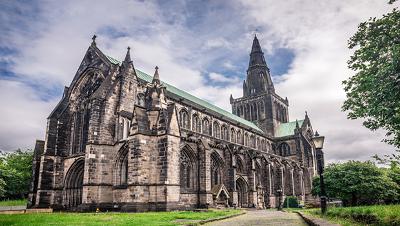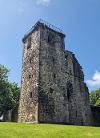
Medieval Glasgow
An overview of Glasgow's Medieval History.
Whilst celebrating the last 850 years of the city, it is important to note that the beginnings of medieval Glasgow start around 1119 with the building of the Cathedral on the site of St Kentigern's first church, the patron saint of Glasgow.
Medieval Glasgow ran from the River Clyde, up through the Saltmarket along High Street and up to the Cathedral. The recent development of the High Street area has led to archaeological excavation, which has uncovered many hidden gems, giving us a better understanding of Glasgow as a medieval burgh.

Coat of Arms
Glasgow's Coat of Arms also has medieval and earlier roots with the fish and the bird appearing in the 13th century and all of the symbols first appearing together in the 15th century.
For more information on Glasgow's medieval past please view the attached Medieval Map Trail.
The city still has many medieval treasures to explore:

Provan Hall
Provan Hall is an A listed medieval building in the heart of Easterhouse. Dating back to the 1470s, it is one of Glasgow's oldest houses.
The recent renovation of Provan Hall has provided an opportunity to breathe new life into one of Glasgow's oldest buildings.
A community heritage site of national significance, the venue which is open to the public, is committed to providing a community facility to support building knowledge, skills, access to arts, heritage and recreation in Easterhouse and welcoming visitors from far and wide.

Provand's Lordship
Provand's Lordship, the oldest house in Glasgow, has reopened after a £1.6 million repair and improvement programme. Provand's Lordship was built in 1471. It is one of only four surviving medieval buildings in Glasgow.
A visit to Provand's Lordship offers an opportunity to step back in time. Discover what life was like in the city 500 years ago at this free to visit venue.

The Cathedral
Stand in the spot where Scotland's largest city first began to take shape. The thriving burgh that sprang up around Glasgow Cathedral has since grown into the vibrant city we know today.
The awe-inspiring building dedicated to St Kentigern, also known as St Mungo, was built in the 1100s and drew countless pilgrims to his shrine.
Today, it's the most complete medieval cathedral on the Scottish mainland, having survived the Protestant Reformation almost intact.

Crookston Castle
Perched on a hill in the southwestern fringes of Glasgow, Crookston Castle is the city's last remaining medieval stronghold, standing as a testament to nearly 900 years of history.
From its battlements, the eye can trace the surrounding neighbourhoods of Greater Pollok, nestled between urban woodlands and green spaces, with ancient waterways winding through the landscape.
Throughout the centuries, the Castle has borne witness to tales of kings and queens, including its connections to Mary, Queen of Scots, which were immortalised in Sir Walter Scott's novel, The Abbot.
The castle was donated to the National Trust for Scotland in 1931, its first ever property and is today managed by Historic Environment Scotland and celebrated by the Friends of Crookston Castle group.




